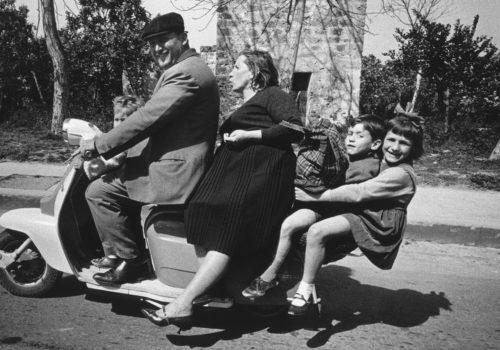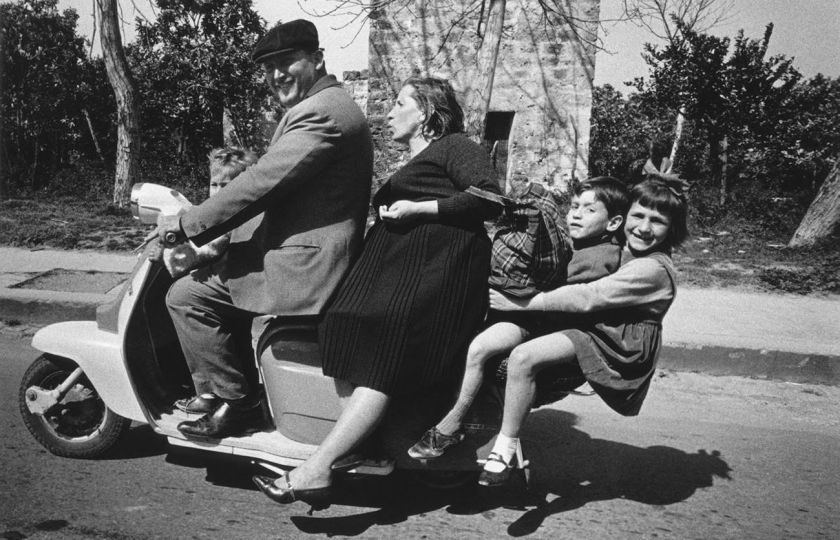To coincide with the exhibition of Bruno Barbey’s photographic series The Italians, shown at Académie des Beaux-Arts, L’Œil de la Photographie spoke to its two curators, Caroline Thiénot-Barbey and Jean-Luc Monterosso, about the career of the Franco-Swiss photographer and academician.
Caroline Thiénot-Barbey and Jean-Luc Monterosso, to begin with, could you tell us about your meeting with Bruno Barbey?
Caroline Thiénot-Barbey (CTB): I met him in 1970. Unfortunately, it wasn’t during the Italian era. Shortly after we met, I spent three months with him in South America: Argentina in particular, on the return of Juan Perón, and Chile shortly before the coup d’état. At first I wrote the texts for his photographs, but then, when Beaulieu distributed cameras to some photographers, including Bruno, I became interested and started documenting his work on film. Later, I took charge of his exhibitions and then, thanks to the arrival of digital technology, I was able to make videos presenting his work. Before he died, he was working on an edition of Les Italiens with Delpire and we supported the project, right up to this exhibition today.
Jean-Luc Monterosso (JLM): I met Bruno Barbey several times. I knew him mainly through his work on Morocco, but I only really discovered and met him at the time of his retrospective at the Maison Européenne de la Photographie in 2015. He was an elegant, generous man, close to people. It’s no coincidence that, at the age of 21, he managed to capture the Italy of the 1960s so well. For many, he was “THE” photographer of colour, but above all he was a great documentary photographer, a long-term reporter who never sought scoops, and refused to photograph the horrors of war. He knew how to keep the right distance from events and from what he saw. And that is the great quality of his work.
What really moved me in The Italians was the way Bruno Barbey captured the look on people’s faces. What moves you most in the photographer’s work?
JLM: Looks, of course, but not just people’s looks, his own. The way people let themselves be photographed at the time is quite incredible, and would no longer be possible today. As he said himself, “for Italians, it was natural to be in front of the camera”. But Bruno also showed great restraint and kindness. That came into play. It was a Mediterranean view of Mediterranean people, unlike perhaps William Klein, who also photographed Italians, but in a more frontal, American way!
Bruno Barbey is best known for his mastery of colour. What are your thoughts on his work in black and white, which we discover here with The Italians?
CTB: In black and white, he was more into portraits, whereas with colour he was perhaps more into abstraction. Colour and people were very difficult. That’s why, afterwards, there was always the human element, because he was above all a humanist, but in a more pointillist way. It was in Brazil that he took this turn. After that, he never went back to black and white. He was one of the forerunners of colour at Magnum, along with Ernst Haas, whom he greatly admired, and also Harry Gruyaert. At the time it was a difficult choice, rather frowned upon and associated with commercial photography.
JLM: Cartier-Bresson, for example, hated colour. Bruno really discovered it when Edmonde Charles-Roux, the editor of Vogue, entrusted him with this assignment in Brazil. He set off with Kodachrome film and shot several pages in colour. He was a child of colour at a time when colour was only just beginning to make its mark in the United States.
What made him so interested in historical events?
CTB: When he joined Magnum he became interested in photojournalism, which he did at first. Then, in photojournalism he found a niche that interested him, more than journalism as such, because he preferred to be present before or after events. Henri Cartier-Bresson also had this approach.
What was his relationship with photojournalism and his work at Magnum?
JLM: From my point of view, Magnum perhaps curtailed photographers’ spontaneity a little. If you look at Cartier-Bresson, for example, his most important and most personal photographs were taken before Magnum. The constraint of an assignment changes a lot of things and makes us lose a kind of freedom and lightness of vision. The great thing about these photographs of the Italians is that Bruno Barbey took them for his own pleasure.
CTB: What interested him most in photojournalism was the historical aspect and the possibility of delving deeper into certain countries by going back several times. He must have gone back to China ten or fifteen times, as well as to Morocco. He was very interested in the history and culture of each country.
JLM: And Morocco was his Morocco, because he was born there. It wasn’t an assignment, he was taking a very personal look at a country he knew well and where he had lived.
Bruno Barbey also had a special relationship with literature.
JLM: What’s surprising about Bruno, and this is quite rare among photographers, is that he was always accompanied by important writers, Le Clézio or Jean Genet for example. His relationship with literature underlies his images and the stories they tell.
CTB: He never wrote. He always regretted not taking notes as he travelled. He was too focused on his photography. In the same way, although he was passionate about cinema, and his first job was on camera for a Rohmer film, La boulangère de Monceau, he never wanted to do anything other than photography.
Which trip has had the greatest impact on Bruno Barbey?
CTB: I’d say it was his return to Morocco.
JLM: There was also the future trip he wanted to make to Chengdu, in Sichuan, to continue working on China. It was a project that he had and often talked about, but which he was unfortunately unable to complete.
Practical information
Bruno Barbey – The Italians
From 11/05/2023to 02/07/2023
Curators: Caroline Thiénot-Barbey and Jean-Luc Monterosso
Academy of Fine Arts
Pavillon Comtesse de Caen
27 quai de Conti – Paris 6
Free admission, Tuesday to Sunday, 11am – 6pm
Further information on the website.


















